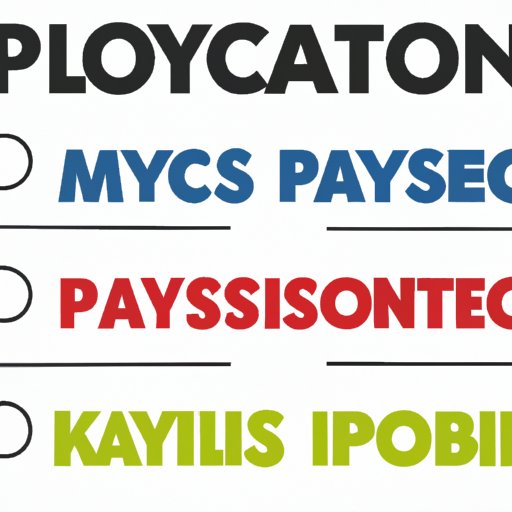Introduction
Payroll is an essential component of any business, referring to the process of calculating employee wages and withholding taxes. This article will explore how payroll works and outline its importance to businesses, as well as examining the benefits of outsourcing payroll, presenting software options and investigating the different types of payroll systems.
Explaining the Role of Payroll in Businesses
Payroll plays a vital role in businesses, ensuring that employees are paid accurately and on time. According to a survey conducted by the American Payroll Association (APA), 78% of employees said that their level of trust in an employer would be affected if their wages were not paid on time or accurately.
The payroll process involves a range of functions, from collecting employee information and calculating wages to processing taxes and filing returns. It is the responsibility of the employer to ensure that all payroll processes are carried out accurately and in compliance with relevant laws and regulations.
Outlining the Process of Calculating Employee Payroll
Calculating employee payroll typically involves the following steps:
Gathering Employee Information
The first step in the payroll process is to gather employee information such as name, address, Social Security number, date of birth, start date, job title and rate of pay. This information is used to create an employee profile which is used to track wages and withholdings.
Determining Employee Wages
Once the employee information has been collected, the next step is to calculate the wages for each employee. This includes calculating regular hourly wages, overtime pay, bonuses, commissions and any other forms of compensation.
Calculating Tax Withholdings
The final step in the payroll process is to calculate the amount of taxes to be withheld from employee wages. This includes federal income tax, state income tax, Social Security tax and Medicare tax. The amount of taxes to be withheld depends on the employee’s filing status, salary and other factors.
Describing Payroll Tax Obligations for Employers
In addition to withholding taxes from employee wages, employers are also responsible for paying payroll taxes. These include federal income tax, Social Security tax and Medicare tax. Employers are also responsible for filing payroll tax returns and remitting payments by the required deadlines.
According to the IRS, “Employers are ultimately responsible for ensuring that payroll taxes are paid timely and accurately. If an employer fails to do so, the employer may be liable for penalties and interest.”

Examining the Benefits of Outsourcing Payroll
Outsourcing payroll can be a cost-effective and efficient solution for businesses. By outsourcing payroll, businesses can reduce administrative costs and free up resources that can be used in more productive areas. Additionally, outsourcing payroll eliminates the risk of costly mistakes and ensures compliance with all applicable laws and regulations.
A survey conducted by the APA found that businesses who outsource payroll reported an average savings of 6.4 hours per week, which could be spent on more strategic activities. Furthermore, businesses who outsourced payroll reported a 73% reduction in payroll processing errors.

Presenting Payroll Software Options Available
Payroll software is a useful tool for businesses to help streamline the payroll process. There are a variety of software solutions available, ranging from basic programs to more advanced systems. Common features of payroll software include employee profiles, wage calculation, tax withholding calculations, filing and payment reminders and reporting tools.

Investigating the Different Types of Payroll Systems
There are two main types of payroll systems: on-premise and cloud-based. On-premise payroll systems are installed locally on a business’s computer and require manual updates. Cloud-based payroll systems, on the other hand, are hosted in the cloud and offer automatic updates and access from any device with internet access.
Conclusion
Payroll is essential for businesses, enabling them to accurately calculate and pay employee wages and taxes. It is important for employers to understand the payroll process, their tax obligations and the benefits of outsourcing payroll. Additionally, there are various payroll software solutions available to streamline the process and different types of payroll systems to choose from.
For more information about payroll, employers should consult the resources provided by the IRS and the American Payroll Association.
(Note: Is this article not meeting your expectations? Do you have knowledge or insights to share? Unlock new opportunities and expand your reach by joining our authors team. Click Registration to join us and share your expertise with our readers.)
